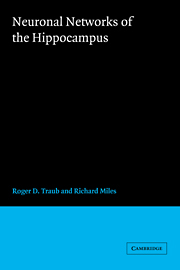Book contents
- Frontmatter
- Contents
- Acknowledgments
- Prologue
- 1 The hippocampus in context
- 2 Physiology of single neurons: voltage- and ligand-gated ionic channels
- 3 Synaptic function and organization of the CA3 region
- 4 The single-cell model
- 5 Model of the CA3 network
- 6 Collective behaviors of the CA3 network: experiment and model
- 7 Collective behaviors of the CA3 network: spontaneous oscillations and synchronized synaptic potentials
- 8 Field effects
- 9 Theoretical approaches: mathematical neural networks
- Conclusion
- Notes
- References
- Index
9 - Theoretical approaches: mathematical neural networks
Published online by Cambridge University Press: 05 February 2012
- Frontmatter
- Contents
- Acknowledgments
- Prologue
- 1 The hippocampus in context
- 2 Physiology of single neurons: voltage- and ligand-gated ionic channels
- 3 Synaptic function and organization of the CA3 region
- 4 The single-cell model
- 5 Model of the CA3 network
- 6 Collective behaviors of the CA3 network: experiment and model
- 7 Collective behaviors of the CA3 network: spontaneous oscillations and synchronized synaptic potentials
- 8 Field effects
- 9 Theoretical approaches: mathematical neural networks
- Conclusion
- Notes
- References
- Index
Summary
The structural features of our hippocampal model are motivated by and largely supported by physiological experiments. In many ways the model works, generating cellular and neuronal population responses that look realistic. Nevertheless, the model is complicated. It involves a number of different parameters, simulations of the model use large amounts of computer time, and there is no obvious way to represent the model in a tractable set of equations. Can we simplify things and make a reduced model that retains “essential features” while gaining in physical or mathematical intuition? (This can be a dangerous game: Essential features may end up being defined as just those features that the reduced model exhibits.)
One approach was discussed briefly in Chapter 7 in the section on chaos: to take one signal generated by the model that represents its average behavior such as the number of pyramidal cells firing as a function of time. We then ask if this output has a small “dimension” (specifically, the correlation dimension). If it does, we might be able to construct a simple system to generate an output indistinguishable from the complex output. Such a system might have less than 15 or 20 variables or “degrees of freedom,” as compared with the thousands of variables in the original system. This approach is intriguing (Babloyantz and Destexhe, 1986; Babloyantz et al, 1985). We need to emphasize that the results for the hippocampal model are extremely preliminary.
- Type
- Chapter
- Information
- Neuronal Networks of the Hippocampus , pp. 204 - 222Publisher: Cambridge University PressPrint publication year: 1991
- 1
- Cited by



